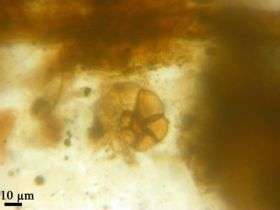Marine plankton found in amber

(PhysOrg.com) -- Marine microorganisms have been found in amber dating from the middle of the Cretaceous period. The fossils were collected in Charente, in France. This completely unexpected discovery will deepen our understanding of these lost marine species as well as providing precious data about the coastal environment of Western France during the Cretaceous.
This work was carried out by researchers at the Géosciences Rennes laboratory (CNRS/Université de Rennes 1), together with researchers from the Paléobiodiversité et Paléoenvironnement laboratory in Paris (CNRS/Muséum national d'histoire naturelle/Université Pierre et Marie Curie) and the Centre de Géochimie de la Surface in Strasbourg (CNRS/Université de Strasbourg 1). It was published in the 11 November 2008 issue of PNAS.
Amber is a fossil resin with a reputation for preserving even the most minute details of insects and other terrestrial arthropods (spiders, scorpions, mites) that lived in resiniferous trees. The forest-based provenance of amber in theory makes it impossible for marine animals to be trapped in the resin.
Nonetheless, researchers from the Géosciences Rennes laboratory have discovered various inclusions of marine plankton in amber from the Mid-Cretaceous (100 to 98 million years BP). These micro-organisms are found in just a few pieces of amber among the thousands that have been studied, but show a remarkable diversity: unicellular algae, mainly diatoms found in large numbers, traces of animal plankton, such as radiolaria and a foraminifer, spiny skeletons of sponges and of echinoderms.
Carried out together with researchers at the Muséum national d'histoire naturelle, the study of diatoms pushed back by 10 to 30 million years the known date for the appearance of certain marine forms of this type of algae. This new information, taken together with recent data on molecular phylogeny, marks a huge advance in our understanding of the complex evolutionary history of diatoms.
The presence of these marine organisms in the amber is an ecological paradox. How did these marine species become stuck and then trapped in the conifers' resin? The most likely scenario is that the forest producing the amber was very close to the coast, potentially shrouded by plankton-bearing mist or flooded by sea water during storms.
The preservation of marine organisms in amber is an exceptional asset, allowing us to deepen our understanding of these lost species and to have a clear idea about the coastal environment of Western France during the Cretaceous.
Citation: Evidence for marine microfossils from amber, V. Girard, A. R. Schmidt, S. Saint Martin, S. Struwe, V. Perrichot, J-P. Saint Martin, D. Grosheny, G. Breton and D. Néraudeau, PNAS, 11 November 2008.
Provided by CNRS





















